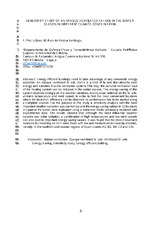Sensitivity study of an opaque ventilated façade in the winter season in different climate zones in Spain
Autor
Peci López, Fernando
Ruiz de Adana, Manuel
Editor
ElsevierFecha
2015Materia
Natural ventilationOpaque ventilated façade
Ventilated façade
Energy saving
Sensitivity study
Energy efficient building
METS:
Mostrar el registro METSPREMIS:
Mostrar el registro PREMISMetadatos
Mostrar el registro completo del ítemResumen
Energy efficient buildings need to take advantage of any renewable energy available. An opaque ventilated façade (OVF) is a kind of façade that absorbs solar energy and transfers it to the ventilation system. This way, the sensible ventilation load of the heating system can be reduced in the winter season. The energy saving of this system depends strongly on the weather variables, mainly solar radiation on the façade, ambient temperature and wind speed. In order to find the most convenient locations where the best OVF efficiency can be obtained, its performance has to be studied along a complete season. For this purpose in this study a sensitivity analysis with the most important weather variables was carried out and the energy saving values in 12 locations in Spain in the winter were evaluated using a numerical model previously validated with experimental data. The results showed that although the most influential weather variable was solar radiation, a combination of high temperatures and low wind speeds can also lead to important energy saving values. It was found that the most convenient locations for installing an OVF were those with low and medium winter severity climates, namely, in the southern and coastal regions of Spain (zones A3, B3, B4, C3 and C4).

